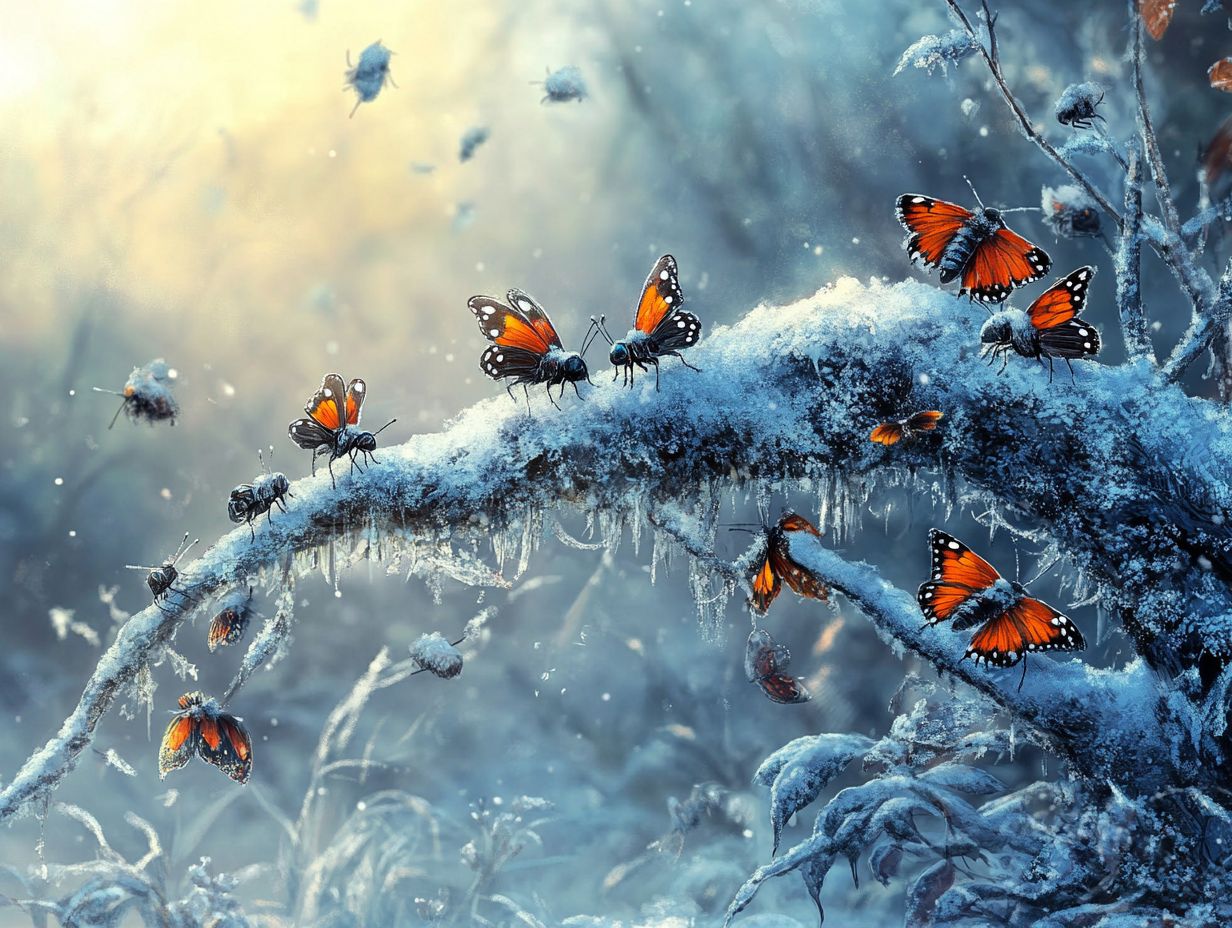Understanding Pest Behavior in Cold Weather
As winter draws near, you might assume that pests simply retreat into hiding. However, the truth is often far more complex.
Cold weather dramatically affects pest behavior. It influences their activity levels and survival strategies. This article delves into how temperature fluctuations impact common pests, including termites and mosquitoes, and the ingenious techniques they employ to endure the chill. We will also discuss proactive measures you can take to prevent infestations in your home, ensuring your environment remains pest-free.
Additionally, we examine the effects of climate change on pest populations, providing you with a thorough understanding of pest dynamics during the colder months. Get ready to tackle any winter challenges with knowledge on your side!
Contents
- Key Takeaways:
- How Cold Weather Affects Pest Behavior
- Common Winter Pests
- Preventing Pest Infestations in Winter
- Dealing with Existing Pest Infestations in Cold Weather
- Impact of Climate Change on Pest Behavior
- Frequently Asked Questions
- What is pest behavior in cold weather, and how does it relate to adaptations of species like the North American woolly bear caterpillar?
- How do pests survive in cold weather?
- What types of pests are more active in cold weather?
- How does cold weather affect pest reproduction?
- What are some signs of pest activity in cold weather?
- How can I prevent pests from entering my home in cold weather?
Key Takeaways:

- Cold weather can greatly affect pest behavior, causing decreased activity levels and the activation of survival techniques to withstand harsh conditions.
- Common winter pests have adapted to thrive in cold weather, such as rodents seeking shelter and insects hibernating in homes.
- To prevent pest infestations in winter, effective strategies include sealing cracks and gaps, proper storage of food, and regular maintenance of outdoor areas.
How Cold Weather Affects Pest Behavior
Cold weather has a profound effect on pest behavior, prompting various insects like ants, bed bugs, cockroaches, mosquitoes, and termites to adjust their survival strategies. Understanding pest resistance in cold climates is especially important during the winter months.
As temperatures decline, these pests instinctively seek out warm environments. They often make their way into homes to withstand harsh conditions. This behavior can lead to a rise in indoor infestations and associated health risks.
Grasping these shifts in behavior is essential for implementing effective pest management and preventive measures against unwanted intruders. This is particularly important during the colder seasons when many insects are overwintering or migrating toward human dwellings.
Temperature and Activity Levels
Temperature plays a crucial role in shaping the activity levels of various pests during the winter months. It influences their behavior and survival techniques.
As the mercury drops, you ll notice certain pests, like the common housefly and various beetle species, experiencing significant shifts in metabolic rates and reproductive activities. Many insects respond by entering a state of diapause a state of rest that helps them save energy and endure harsh conditions.
On warmer winter days, however, these pests may spring back to life, actively seeking food sources and opportunities to mate. Fluctuations in humidity can also intensify these behaviors; higher moisture levels promote the growth of mold and mildew, creating perfect breeding grounds for pests such as termites and cockroaches.
These adaptable creatures tend to establish colonies in more favorable small, suitable places, ensuring their survival even in challenging environments.
Survival Techniques
Pests have a variety of clever survival techniques they employ during winter, including ways to survive through winter that enable them to seek shelter and find food sources even in challenging conditions.
You might find that these adaptable creatures often take refuge within the warm confines of your home. They take full advantage of the insulation provided by your walls and attics. By slipping through small cracks and crevices, they can discover a safe haven that also grants them access to moisture a crucial resource for their survival.
For instance, insects may gravitate toward leaky pipes or humid areas like bathrooms and kitchens. This effectively fosters an environment that not only sustains them but also supports their reproductive cycles. Many pests also use energy conservation methods, entering a state of dormancy and reducing their metabolic rates to endure the cold months when food becomes scarce.
In conclusion, understanding how pests behave in winter is vital for maintaining a pest-free environment in your home. Stay proactive and prepared to deter any unwanted visitors during the colder months!
Common Winter Pests

Understanding the common pests that seek refuge in homes during cold months is crucial for effective pest management. You ll often encounter species such as ants, bed bugs, cockroaches, mosquitoes, termites, and rodents.
These pests adapt their behaviors to survive winter and frequently migrate indoors in search of warmth and food. This can lead to significant damage if not controlled.
As temperatures dip, their activity levels shift, leaving your property vulnerable to infestations. By recognizing their habits and habitats, you can take proactive measures, including regular inspections, to safeguard your home against these unwelcome winter visitors.
Types of Pests and Their Habits
The pests that remain active during cold weather include ants, bed bugs, cockroaches, mosquitoes, and termites. Each showcases unique habits designed for survival.
For instance, ants often seek refuge indoors and establish colonies in wall voids or beneath floors for warmth and easy access to food. Bed bugs cleverly hide in the seams of mattresses and upholstered furniture, waiting for someone to come along so they can feed.
Cockroaches, notorious for their resilience, navigate tight spaces and thrive in kitchens, where crumbs linger. Mosquitoes are generally less active, but some species may still persist in sheltered areas, eager to feed on any available blood sources.
Termites, driven by survival instincts, may create mud tubes to traverse between their nests and food sources, ensuring they remain concealed from the elements.
Preventing Pest Infestations in Winter
Act now to keep pests out this winter! Preventing infestations requires a proactive approach to deter unwelcome guests, such as rodents and insects, from invading your home.
Start by identifying potential entry points, eliminating moisture sources, and maintaining a clean environment to reduce food availability for pests. These measures not only protect your indoor spaces but also minimize the health risks that often accompany infestations.
Effective Prevention Strategies
To keep your home pest-free this winter, you need effective prevention strategies. Focus on conducting regular inspections and managing moisture levels.
Prioritize sealing any cracks and crevices around doors, windows, and foundations, as these are prime entry points for pests. A clutter-free environment not only enhances your property’s aesthetic but also minimizes hiding spots for unwanted critters.
Managing moisture levels is crucial; fix leaks promptly and use dehumidifiers in damp areas to deter pests. These steps are crucial for keeping your home safe throughout the colder months.
Dealing with Existing Pest Infestations in Cold Weather

Navigating existing pest infestations during cold months requires specific treatments based on the pests in your home. Whether it s ants, cockroaches, bed bugs, or termites, these guests can inflict considerable damage and pose health risks if left unchecked.
By understanding their behaviors and habitats, you can choose the right treatments and implement strategies that not only thwart future infestations but also maintain a healthy living environment throughout the winter chill.
Treatment Options and Best Practices
When you encounter pest infestations during the chilly months, there are various treatment options and best practices that can effectively manage the situation while ensuring both safety and efficiency.
These methods encompass a diverse array of approaches. You might consider chemical treatments that specifically target pest species while minimizing any negative impact on beneficial insects.
Additionally, biological controls can harness the power of natural predators to keep pest populations in check.
Don t overlook mechanical controls, such as traps and barriers, which can prove effective without the need for chemicals. It’s essential for homeowners and property managers to understand that in instances of severe infestations, seeking professional consultation is often necessary to devise a comprehensive strategy.
Experts possess the expertise to recommend the most suitable methods tailored to your specific circumstances, ensuring not only long-lasting results but also your peace of mind.
Impact of Climate Change on Pest Behavior
The influence of climate change on pest behavior is becoming unmistakably clear. As temperatures rise and environmental conditions shift, you may notice significant changes in pest populations, their distributions, and activity patterns.
With the climate in flux, pests might relocate to new habitats, refine their survival tactics, and extend their ranges. All of these changes create fresh challenges for pest management and public health.
Understanding these changes is crucial for you to effectively manage pest control strategies that take into account the evolving behaviors of pests in response to these climatic changes, particularly during seasonal transitions.
Effects of Warming Temperatures on Pest Populations
Warming temperatures are dramatically shaping pest populations, and the effects are becoming increasingly urgent! These changes influence pest behavior, reproduction, and geographic distribution, especially among species like the American cockroach and the German cockroach.
As the climate continues to evolve, you may notice that many pests are enjoying enhanced reproductive rates, enabling their populations to swell at an unprecedented pace.
This surge initiates a domino effect within ecosystems, disrupting the delicate balance between flora and fauna, and affecting the habitats of various pests, including Monarch Butterflies and Eastern tent caterpillars.
Pests are expanding their habitats into regions that were once too cold for survival, adding stress to local agriculture and native species.
As warmer climates become the new norm, the intricate relationship between climate change and pest dynamics emerges, posing threats to both agricultural productivity and biodiversity. This ultimately presents significant challenges for effective ecological management and pest control strategies, especially for companies like Home Run Pest & Termite Control in Las Vegas.
Frequently Asked Questions

What is pest behavior in cold weather, and how does it relate to adaptations of species like the North American woolly bear caterpillar?
Pest behavior in cold weather refers to the actions and habits of various pests during colder temperatures. This includes understanding pest life cycles in cold weather, as well as any changes in their behavior compared to warmer weather.
How do pests survive in cold weather?
Some pests have adaptations that allow them to survive in colder temperatures. For example, rodents may burrow underground, while insects may seek shelter in warm buildings. Understanding the effects of frost on pests reveals that some may also enter a dormant state during the winter months, while others, like drywood termites and subterranean termites, may remain active.
What types of pests are more active in cold weather?
Certain pests, such as rodents, are more active in colder temperatures as they seek warmth and shelter. Other pests, like cockroaches, may also be more active in the winter due to an increase in food sources indoors.
How does cold weather affect pest reproduction?
Cold weather impacts pest reproduction in a few ways. Some pests breed less during winter, while others lay eggs in warmer spots to survive.
Additionally, cold weather can drive pests to seek shelter indoors. This can lead to increased breeding and infestations.
What are some signs of pest activity in cold weather?
Look for signs of pests indoors. These can include sightings, droppings, gnaw marks, and damage to food or property.
Be alert for changes in behavior. If pests are more active during the day, it might indicate a larger infestation.
How can I prevent pests from entering my home in cold weather?
Seal any cracks or openings to keep pests out. Store food properly and maintain a clean, clutter-free environment.
Regular pest control services can also help identify potential entry points. Don’t wait take action now to protect your home from winter pests!






